|
Reviews
Keyboard Magazine
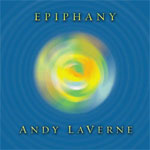 As if to underscore the fact that we at Keyboard are all about the
music, Andy LaVerne has released a new CD. Andy’s disc, entitled Epiphany,
is his second release on the Clavebop label. The disc offers a new take on
the organ trio: In addition to Andy on piano and Danny Gottlieb on drums,
organist Gary Versace rounds out the lineup. Andy’s article on Gary appeared
on our July issue, and if you read it, you’ll recognize Gary’s unique B-3
approach instantly. Andy penned all the tunes, which are as adventurous as
they are fun to listen to. The combination of these three virtuosos of the
piano, B-3, and drums and the freedom and structure of Andy’s compositions
is absolutely engaging. As if to underscore the fact that we at Keyboard are all about the
music, Andy LaVerne has released a new CD. Andy’s disc, entitled Epiphany,
is his second release on the Clavebop label. The disc offers a new take on
the organ trio: In addition to Andy on piano and Danny Gottlieb on drums,
organist Gary Versace rounds out the lineup. Andy’s article on Gary appeared
on our July issue, and if you read it, you’ll recognize Gary’s unique B-3
approach instantly. Andy penned all the tunes, which are as adventurous as
they are fun to listen to. The combination of these three virtuosos of the
piano, B-3, and drums and the freedom and structure of Andy’s compositions
is absolutely engaging.
Jazz Times
 CONRAD HERWIG/ANDY LAVERNE - Shades of Light (SteepleChase) CONRAD HERWIG/ANDY LAVERNE - Shades of Light (SteepleChase)
For Shades of Light (SteepleChase) the duo of trombonist Conrad Herwig and
pianist Andy LaVerne chose some great tunes by great writers-the likes of
Corea, Coltrane, Jobim, Ellington and Brubeck… Best collaboration: Joe
Henderson's "Black Narcissus," where LaVerne opens up following a mysterioso
and impressionistic intro and enhances Herwig's consistently silken tone.
Most interesting track: Brubeck's "In Your Own Sweet Way," where the
challenging changes bring out the most creative moments by both as they
trade eights, then fours.
-Harvey Siders
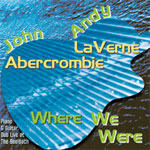 ANDY LAVERNE AND JOHN ABERCROMBIE - Where We Were (Double-Time) ANDY LAVERNE AND JOHN ABERCROMBIE - Where We Were (Double-Time)
Pianist Andy LaVerne and guitarist Abercrombie have been performing duos
since their student days in Boston during the late 1960s. Here, we catch the
latest installment of their ongoing adventures. Recorded live at the
Seelbach in Louisville, LaVerne and Abercrombie thread neon strands through
tapestries which pulsate and glow.
Looming in the background are the long shadows of Bill Evans and Jim Hall,
another piano-guitar tandem that had something distinct to say. Indeed, the
soaring arcs let loose by LaVerne and Abercrombie evoke the kind of edgy
ethereality that Evans and Hall, along with Miles Davis, helped establish as
jazz-worthy. The music dances uninhibitedly in deep space.
Another plus lies in the duo's distinct sonic profile. Like Hall, or Evans,
or Davis, or Getz or Coltrane, Abercrombie and LaVerne possess signature
sounds that in tandem are simply exquisite. Did I mention their capacity to
invent? That, too, is amazing. Here, standards such as "Softly as in a
Morning Sunrise" alternate with bracing originals like LaVerne's "Soulstice"
and Abercrombie's
-Chuck Berg
 ANDY LAVERNE TRIO - Bud's Beautiful (SteepleChase) ANDY LAVERNE TRIO - Bud's Beautiful (SteepleChase)
Recorded in March of 1996, this session apparently pre-dates the release of
Chick Corea's all-star tribute record to Bud Powell, the great seminal bebop
pianist. Though Andy Laverne may owe less to Bud's pointillistic attack than
Corea, he clearly has a deep appreciation for the master's approach to form
and improvisation, and a knack for finding an inspired way through Bud's
complex conceptions. Laverne here brings together his own set of
all-stars-Peter Washington on bass and Billy Hart on drums add light and
substance to any session-on a set of a dozen tunes, all from Powell's pen
save Laverne's lovely title tribute. The tunes range from familiar to
[undeservedly!] obscure, while avoiding such known quantities as "Parisian
Thoroughfare." Laverne's medleys add more than a dash of intrigue to the
mix: "Bouncing with Bud," for example, merges delightfully with "Bud's
Bubble." Great music, great trio, great concept.
-Bill Bennett
 ANDY LAVERNE - Four Miles (Triloka) ANDY LAVERNE - Four Miles (Triloka)
Tributes to Miles Davis abound. This is one of the best-perhaps the best, a
date marked by sensitivity, poise and maturity. The players are LaVerne,
piano; Randy Brecker, trumpet and fluegelhorn; George Mraz, bass; Al Foster,
drums. The program consists of tunes associated with Miles or his sidemen.
The quartet starts with "When You Wish Upon a Star," a ballad. LaVerne
clothes Brecker's fluegelhorn in rhapsodic chords and then solos
economically and lyrically. "Summertime" begins with the piano playing Gil
Evans' scalar background line from the famous Miles Ahead album as the
Harmon muted trumpet evokes Miles. "Evokes" is an operative word throughout
this album; Brecker is not an imitator.
Nor is LaVerne, although the touch of his teacher, Bill Evans, surfaces
frequently in his playing.
LaVerne's arrangements include reharmonization (evident on "When You
Wish...," "'Round Midnight" and others) and structural extensions ("All
Blues"), devices that give the date a unity beyond a jam session. It is
clear that the musicians are playing thematically, too. You definitely need
to check this album out.
-Owen Cordle
 ANDY LAVERNE - Another World, Another Time (SteepleChase) ANDY LAVERNE - Another World, Another Time (SteepleChase)
Pianist Andy LaVerne, in his younger days in 1977, recorded an album for
Steeplechase entitled Another World. The fresh-faced LaVerne, then a member
of Stan Getz's band, penned a colorful group of pieces for that album, that
were impressive for their impressionistic modernity. Now, more than twenty
years later, producer Nils Winther reconvened the same musicians to record
the same pieces again. The plan isn't a gimmick; the artists are able to
deliver a fresh and revealing perspective. This project is an intriguing
concept that other artists and producers might consider trying. The one
catch here is that the original album was a trio, but trumpeter Tim Hagans
is added, along with the returning Mike Richmond and Billy Hart. However,
the slight change in the instrumentation also adds a different nuance. In
its more minimalist attention to intellectual detail and coloristic writing,
as opposed to rhythmic drive, the music is typical of one branch of late
'70s developments. Revisited, the music stands up today and reveals that
many of these directions have been incorporated in the contemporary palette.
On this recording, the artists bring a mature approach that further reveals
how this type of music has been assimilated into jazz.
-Sid Gribetz
 ANDY LAVERNE/DAVE SAMUELS - Between Earth and Mars (SteepleChase) ANDY LAVERNE/DAVE SAMUELS - Between Earth and Mars (SteepleChase)
There's no doubting Andy LaVerne's technical skill on the piano and his
impressive credentials, which include fusion, big band, straightahead and
some impressive solo works. Vibist Dave Samuels, who distinguished himself
with Spyro Gyra, and bassist Jay Anderson. There's no doubting the
improvisational skills throughout the nine works. There are moments:
Samuels' "Tri-Tones" and Gary Peacock's "B.E." build slowly to satisfying
conclusions, and LaVerne's title song is propelled by Samuels' pounding
strokes. LaVerne takes a chance here by fronting a piano-vibes-bass trio.
-Brian Soergel
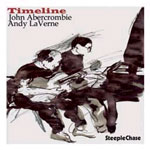 JOHN ABERCROMBIE/ANDY LAVERNE - Timeline (SteepleChase) JOHN ABERCROMBIE/ANDY LAVERNE - Timeline (SteepleChase)
Although John Abercrombie has done his fair share of experimentation over
the years, at the heart of his work is a musicality-as evident throughout
Timeline that has led him to work with many of the finest musicians in
contemporary jazz, including Michael Brecker, Jack DeJohnette and the late
Michel Petrucciani.
On Timeline, pianist Andy LaVerne joins Abercrombie for a musical
celebration of the influential, historic collaborations between Jim Hall and
Bill Evans, who laid to rest notions that the harmonic properties of the
guitar and piano were incompatible. Many of the tunes may be the same as
those played by Hall and Evans; however, don't get the idea that this is
somehow a re-creation; Abercrombie and LaVerne bring their own values and
sensibilities to bear throughout the set. One element that Abercrombie and
LaVerne share with Hall and Evans, however, is their conversational rapport,
something that is particularly evident on tunes like "My Funny Valentine"
(check out how Abercrombie updates Hall's role by playing walking bass lines
behind LaVerne at one point) and the beautiful reading of "Darn That Dream,"
where guitar and piano seamlessly meld voices. Departing a bit from the
Hall/Evans theme, LaVerne brings three original compositions to the table,
including the lightly swinging "Inner Voice" and "Adagio," which closes the
program on a lyrical note.
-Jim Ferguson
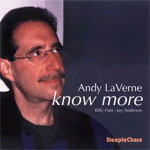 ANDY LAVERNE - Know More (SteepleChase) ANDY LAVERNE - Know More (SteepleChase)
The trio provides a haven for many of the music's creativity addicts, among
whom we are sure to find Andy LaVerne. His latest work, Know More (SteepleChase
SCCD 31493; 66:36), is by turns thoughtful, thunderous, sly, touching.
LaVerne wrings all one can out of this trio, which includes bassist Jay
Anderson and, once again, the nonpareil Billy Hart on drums. LaVerne finds
his own way through the changes, whether he's put them together, as with the
title track, or borrowed from the likes of "Stella by Starlight," as he does
for his "Fire Wire." "Sudden Wealth Syndrome" is a powerful, Traneish work,
with yet another wonderfully articulate Hart solo. "Where and When" is a
particularly poignant ballad, with LaVerne's liquid phrasing bringing it
home. "Waltz King" is a fine example of trioism with its fickle time
signatures and teasing ambiguities.
-Bill Bennett
Down Beat
 Shades Of Light - Steeplechase 31520 Shades Of Light - Steeplechase 31520
With Andy Laverne’s mannerly, precision piano, Herwig hews staunchly to fine
melodies and makes his horn sing. The two offer textbook versions of the
bebop songbook, touching neglected classics with aplomb and joy.
Fred Bouchard
allaboutjazz.com
 Between Earth & Mars - Andy LaVerne & Dave Samuels | SteepleChase
Records Between Earth & Mars - Andy LaVerne & Dave Samuels | SteepleChase
Records
Track Listing: Retrospect, Gardenia, On Green Dolphin Street, Tenderly, Blue
in Green, Tri-Tones, Maiden Voyage, Between Earth & Mars, B.E. (68:30)
Personnel: Andy LaVerne- piano, Dave Samuels- vibes, Jay Anderson- bass
Pianist Andy LaVerne possesses talent that should be commensurate with a
much broader public awareness. One of sax legend Stan Getz’s favorite
accompanists, LaVerne has built a sizable catalog for SteepleChase over the
past two decades- some 18 strong- withBetween Earth & Marsserving as a
reunion with vibist Dave Samuels. Also thrown into the mix is bassist Jay
Anderson, who completes this rather atypical trio.
Far away from his visibility as a past member of the popular group Spyro
Gyra, Samuels contributes a singular performance that reminds us that he is
indeed one of the finest practitioners of his craft. LaVerne strives in this
type of configuration as his style is strongly rooted in a deep sense of
lyricism and an advanced harmonic knowledge. Anderson does enough to keep
things buoyantly afloat to the point that a drummer just isn’t missed.
The piano and vibes combination is a real winner- of course Gary Burton and
Chick Corea taught us that long ago- and LaVerne and Samuels have developed
attractive arrangements that make the most of a smart mix of contemporary
standards and originals. “Blue In Green” is especially arresting in this new
form, taken a bit faster than the original (check out another fine duo
performance of this one by Burton and Ralph Towner). The title cut, a
LaVerne tune, is also a highpoint, sporting an intense solo from Samuels. It
may have taken almost a decade for LaVerne and Samuels to create a follow-up
to Fountainhead but it was well worth the wait.
~ Chris Hovan
 John Abercrombie/Andy LaVerne "Timeline", SteepleChase SCCD 31538 *** John Abercrombie/Andy LaVerne "Timeline", SteepleChase SCCD 31538 ***
For more than 10 years now (remember albums like "Natural Living" or "Now it
can be Played"), John Abercombie and Andy LaVerne have contributed and
enriched the tradition of the guitar-piano duet having become a sort of
musical conversation being simultaneously free and intimate. Thanks to all
this experience they can now dare a risk-taking which transforms their
complicity in the instant moment into classicism. The repertory which they
are interpreting here is a perfect mix: "All Across the City" from Jim Hall
and "Turn Out the Stars" from Bill Evans in homage to the duets of "Intermodulation",
three beautiful themes from Andy LaVerne and a package of never becoming
out-fashioned standards on which the respective qualities of the two
musicians make wonder: Abercombie develops long and very dense phrases - but
always very readable - from a melodic-harmonic point of view on themes which
are particularly suitable such as "You go to my head" or "I'm getting
sentimental over you". Andy LaVerne provides him essential support and
allows himself convincing solos which makes the rhythmical contribution of
Evans profitable. But over all, it's the extremely sharpened harmonic sense
that the two musicians show, the fineness of their inflexions (augmented or
diminished chords, suspended harmonies) of which have been perpetually taken
advantage of to enrich their personal speech and to support the sense of
their dialog. This is an exemplary harmony (which reveals to be at the same
time an outstanding demonstration of equilibrium and musical quality while
listening).
Stéphane Carini, Jazzman n°94, September 2003
 Andy
LaVerne: Epiphany & Process of Illumination Andy
LaVerne: Epiphany & Process of Illumination
Posted: 2004-12-03
By E.J. Iannelli
When considering these two discs by pianist Andy LaVerne, it's easy to think
that he has some kind of obsession with the revelatory experience. That may
be so. But the similarity between the titles seems to be more coincidental
than anything else. The first comes from the unusual inspiration to form a
piano/organ (not one or the other, but both) trio, the second from a “slip
of the tongue by a friend” that upon reflection took on additional meaning.
LaVerne has honed his chops over the years as a sideman to the big
names—Sinatra, Getz, Woody Herman, Diz and Chick Corea are just a few of
them—and as a bandleader as well, with dozens of records under his own name
on the Concord and SteepleChase labels, among many others. Technique and
expressivity, the yin and yang of music-making, are therefore here in
abundance. His further abilities as a composer on both Epiphany and Process
of Illumination, his second and third albums as leader for the Florida-based
label ClaveBop, are manifest. Of the twenty-two songs to fill out this pair
of albums, not one is a standard.
You'll be pardoned for raising an eyebrow at the idea of a piano/organ trio
like the one found on Epiphany. The arrangement seems destined to generate a
lot of level crossfire, more or less canceling one another out. Yet in
practice the two keyboard instruments are surprisingly complimentary and not
at all competitive. Gary Versace maximizes the juicy punch of the organ,
contrasting the sharper tinkle and shine of LaVerne on piano. “Creature
Comforts,” one of the album's many highlights, is also one of the best
examples of how the two make excellent use of the similarities and
differences of their respective instruments. Acting together, the cushiony
and fluid notes of the organ buoy its clearer cousin. Acting in opposition,
they threaten to envelop and sink it. This works just as well as on the
slower ballads like “Tear Drop” as on the more spirited numbers like “This
Just In.”
On “Antipathy,” Versace murmurs the bassline while LaVerne floats freely
overhead with the melody; then LaVerne bows out, leaving Versace and drummer
Danny Gottlieb alone to develop a groove out of rounded growls and broken
whispers. It's a veritable party when all three reunite. The overall effect
is more remarkable than I was initially prepared to give this peculiar trio
combination credit for. May it inspire others to do the same—though this
will undoubtedly be a tough act to follow.
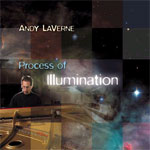 Andy
LaVerne Andy
LaVerne
Process of Illumination
Clavebop
2004
Process of Illumination, recorded over two years ago, features a more
traditional lineup than Epiphany but there is also a more deliberate method
behind it. As the title track illustrates, LaVerne is concerned with the
dynamics of jazz and individual development, namely the natural evolution
from simplicity toward greater complexity. “Process of Illumination” is at
its core a basic tune, though it gets dressed up and embellished slightly as
it progresses along its ten-minute run. As if baby-stepping the listener
through another stage of development, the following track, “Good Luck with
Your Music,” sounds as zingy and straightforward as a swinging showtune, but
LaVerne begins to break it apart and subject it to slight tempo changes and
chromatic fireworks. Gottlieb (appearing again) and bassist Mark
Neuenschwander are more than willing to help him in this exercise. Lest he
go unmentioned, tenor saxophonist Gary Campell plays with cool intensity
throughout the two-day session.
Both of these noteworthy discs are just the latest in a long line of CDs to
cross my desk with running times in excess of the 70-minute mark. I have
mixed feeling about this. On the one hand it's wonderful to get so much
music for one's money; on the other it tends to seem like a surfeit.
Particularly where LaVerne is concerned in terms of intricacy and scope,
it's almost necessary to divide each disc into two parts in order to get the
most out of it. This, of course, shouldn't discourage anyone from checking
out this pair of albums, not to mention other ClaveBop offerings. The label
has released some strong records of late.
 MASTER CLASSES WITH JOHN ABERCROMBIE AND ANDY LAVERNE MASTER CLASSES WITH JOHN ABERCROMBIE AND ANDY LAVERNE
A Master Class with pianist Andy LaVerne and guitarist John Abercrombie is
an educational, entertaining, and inspiring event. LaVerne and Abercrombie,
longtime musical collaborators and friends, first met in 1968 in Boston
while both were students at the Berklee College, and got their inspiration
from Bill Evans and Jim Hall. Well schooled in the theory of jazz, both have
been playing, teaching, and giving Masterclasses for students and audiences
in Colleges and Universities worldwide for many years.
A typical LaVerne/Abercrombie Master Class usually begins with the duo
playing a selection from one of their recent recordings. From there, a
discussion based on various elements of the music follows. Topics discussed
might include: chord/scale usage, voicings, creating lines and melodies,
comping, time feel and articulation, composition, harmony, attitude and
business, as well as musical conceptions. Depending on the students present,
Andy and John might take pianists and guitarists separately, for more
detailed work. They might also have students play, and critique them, or
play with some students as well.
The Master Class will generally end with some more spirited playing from
LaVerne and Abercrombie,
to demonstrate further the concepts covered earlier.
This is truly an "Edutainment" event, not to be missed!
|
|